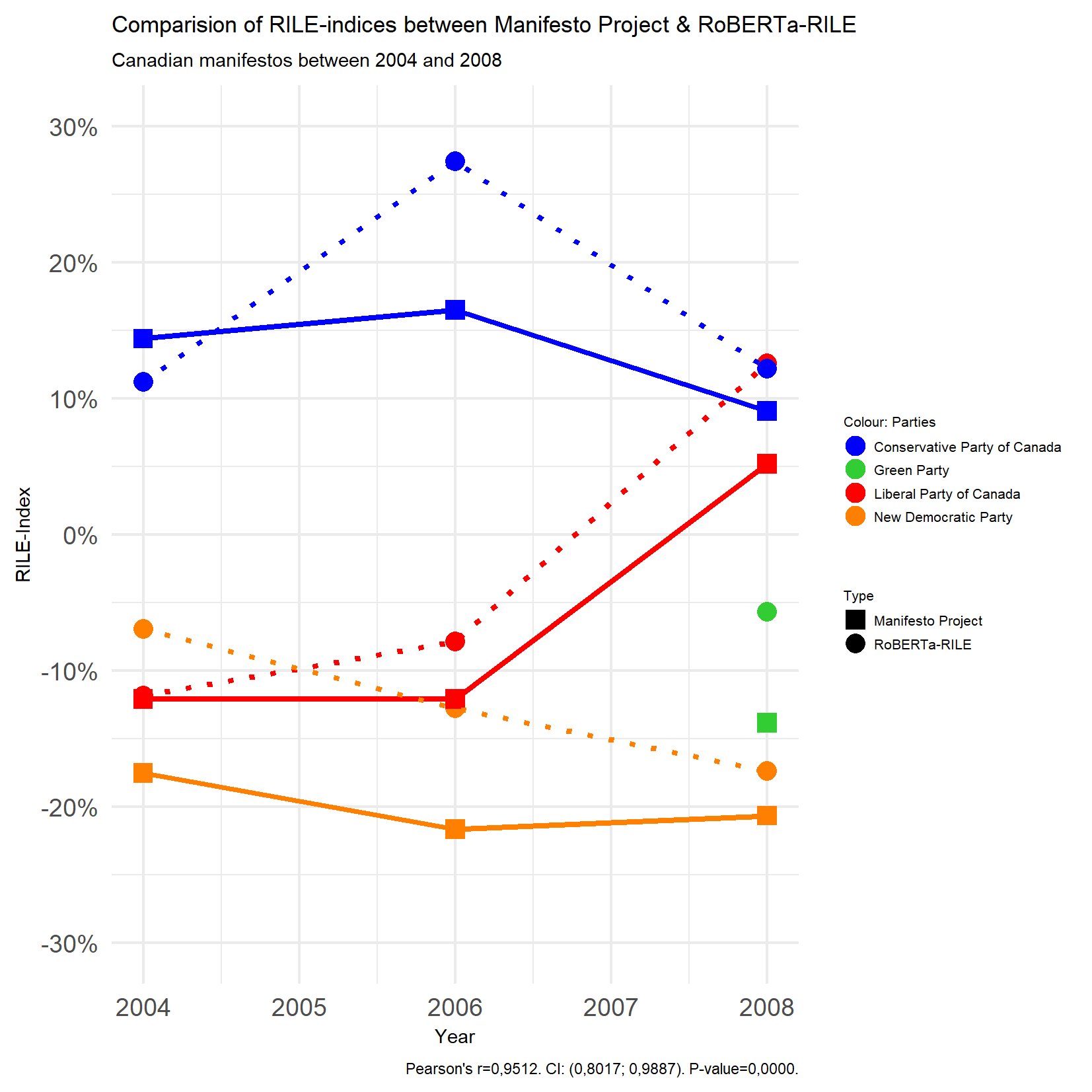RoBERTa-RILE
This model is a fine-tuned version of roberta-base on data from the Manifesto Project.
Model description
This model was trained on 115,943 manually annotated sentences to classify text into one of three political categories: "neutral", "left", "right".
Intended uses & limitations
The model output reproduces the limitations of the dataset in terms of country coverage, time span, domain definitions and potential biases of the annotators - as any supervised machine learning model would. Applying the model to other types of data (other types of texts, countries etc.) will reduce performance.
from transformers import pipeline
import pandas as pd
classifier = pipeline(
task="text-classification",
model="niksmer/RoBERTa-RILE")
# Load text data you want to classify
text = pd.read_csv("example.csv")["text_you_want_to_classify"].to_list()
# Inference
output = classifier(text)
# Print output
pd.DataFrame(output).head()
Training and evaluation data
Training and evaluation data
RoBERTa-RILE was trained on the English-speaking subset of the Manifesto Project Dataset (MPDS2021a). The model was trained on 115,943 sentences from 163 political manifestos in 7 English-speaking countries (Australia, Canada, Ireland, New Zealand, South Africa, United Kingdom, United States). The manifestos were published between 1992 - 2020.
| Country | Count manifestos | Count sentences | Time span |
|---|---|---|---|
| Australia | 18 | 14,887 | 2010-2016 |
| Ireland | 23 | 24,966 | 2007-2016 |
| Canada | 14 | 12,344 | 2004-2008 & 2015 |
| New Zealand | 46 | 35,079 | 1993-2017 |
| South Africa | 29 | 13,334 | 1994-2019 |
| USA | 9 | 13,188 | 1992 & 2004-2020 |
| United Kingdom | 34 | 30,936 | 1997-2019 |
Canadian manifestos between 2004 and 2008 are used as test data.
The Manifesto Project mannually annotates individual sentences from political party manifestos in over 50 main categories - see the codebook for the exact definitions of each categorie. It has created a valid left-right-scale, the rile-index, to aaggregate manifesto in a standardized, onde-dimensional political space from left to right based on saliency-theory. RoBERTa-RILE classifies texts based on the rile index.
Tain data
Train data was slightly imbalanced.
| Label | Description | Count |
|---|---|---|
| 0 | neutral | 52,277 |
| 1 | left | 37,106 |
| 2 | right | 26,560 |
Overall count: 115,943
Validation data
The validation was created by chance.
| Label | Description | Count |
|---|---|---|
| 0 | neutral | 9,198 |
| 1 | left | 6,637 |
| 2 | right | 4,626 |
Overall count: 20,461
Test data
The test dataset contains ten canadian manifestos between 2004 and 2008.
| Label | Description | Count |
|---|---|---|
| 0 | neutral | 3,881 |
| 1 | left | 2,611 |
| 2 | right | 1,838 |
Overall count: 8,330
Training procedure
Training hyperparameters
The following hyperparameters were used during training:
training_args = TrainingArguments(
warmup_ratio=0.05,
weight_decay=0.1,
learning_rate=1e-05,
fp16 = True,
evaluation_strategy="epoch",
num_train_epochs=5,
per_device_train_batch_size=16,
per_device_eval_batch_size=16,
save_strategy="no",
logging_dir='logs',
logging_strategy= 'steps',
logging_steps=10,
push_to_hub=True,
hub_strategy="end")
Training results
| Training Loss | Epoch | Step | Validation Loss | Accuracy | F1-micro | F1-macro | F1-weighted | Precision | Recall |
|---|---|---|---|---|---|---|---|---|---|
| 0.7442 | 1.0 | 1812 | 0.6827 | 0.7120 | 0.7120 | 0.7007 | 0.7126 | 0.7120 | 0.7120 |
| 0.6447 | 2.0 | 3624 | 0.6618 | 0.7281 | 0.7281 | 0.7169 | 0.7281 | 0.7281 | 0.7281 |
| 0.5467 | 3.0 | 5436 | 0.6657 | 0.7309 | 0.7309 | 0.7176 | 0.7295 | 0.7309 | 0.7309 |
| 0.5179 | 4.0 | 7248 | 0.6654 | 0.7346 | 0.7346 | 0.7240 | 0.7345 | 0.7346 | 0.7346 |
| 0.4787 | 5.0 | 9060 | 0.6757 | 0.7350 | 0.7350 | 0.7241 | 0.7347 | 0.7350 | 0.7350 |
Validation evaluation
| Model | Micro F1-Score | Macro F1-Score | Weighted F1-Score |
|---|---|---|---|
| RoBERTa-RILE | 0.74 | 0.72 | 0.73 |
Test evaluation
| Model | Micro F1-Score | Macro F1-Score | Weighted F1-Score |
|---|---|---|---|
| RoBERTa-RILE | 0.69 | 0.67 | 0.69 |
Evaluation per category
| Label | Validation F1-Score | Test F1-Score |
|---|---|---|
| neutral | 0.77 | 0.74 |
| left | 0.73 | 0.65 |
| right | 0.67 | 0.62 |
Evaluation based on saliency theory
Saliency theory is a theory to analyse politial text data. In sum, parties tend to write about policies in which they think that they are seen as competent. Voters tend to assign advantages in policy competence in line to the assumed ideology of parties. Therefore you can analyze the share of policies parties tend to write about in their manifestos to analyze the party ideology.
The Manifesto Project presented for such an analysis the rile-index. For a quick overview, check this.
In the following plot, the predicted and original rile-indices are shown per manifesto in the test dataset. Overall the pearson correlation between the predicted and original rile-indices is 0.95. As alternative, you can use ManiBERT.
Framework versions
- Transformers 4.16.2
- Pytorch 1.9.0+cu102
- Datasets 1.8.0
- Tokenizers 0.10.3
- Downloads last month
- 56
